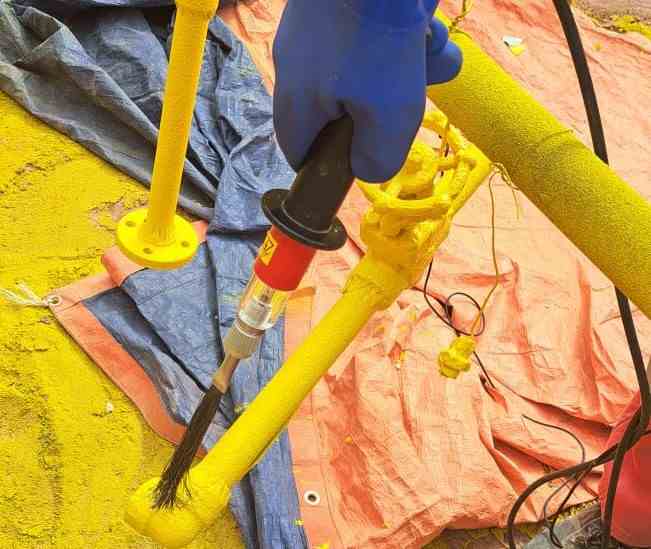Introduction
The holiday season transforms our surroundings with dazzling lights and colorful decorations. Yet, beneath the festive paint adorning structures like market stalls, amusement rides, or public sculptures lies a critical need for protection. High voltage holiday testing of paint ensures these coatings are flawless, shielding metal surfaces from corrosion and keeping the holiday spirit safe. This article dives into why this testing matters, how it’s done, and simple steps to make your holiday setups both stunning and secure.
What is High Voltage Holiday Testing of Paint?
Picture a tiny pinhole in a freshly painted holiday display. That small flaw, called a “holiday,” could let moisture or electricity sneak through, ruining the show or causing damage. High voltage holiday testing—often called spark testing—is a clever way to catch these imperfections in non-conductive paint coatings on metal surfaces. By sending a high voltage across the coating, testers spot weak spots where current slips through, revealing defects like cracks, voids, or thin patches.
During the holidays, this testing is a game-changer for painted surfaces exposed to snow, crowds, or temporary setups. It ensures everything from decorative railings to massive pipelines stays protected and looks great all season long.
Why Does It Matter?
Holiday testing isn’t just about keeping things pretty—it’s about safety and durability. Here’s why it’s a must:
- Weather Woes: Outdoor coatings face rain, frost, or heat swings that can exploit tiny flaws, leading to rust or peeling paint.
- Festive Safety: A defective coating on a carnival ride or public art could expose metal, risking shocks or structural issues.
- Pop-Up Problems: Temporary holiday setups, like market booths, often use coated metal that needs to hold up under heavy use.
- Rule Followers: Industries like infrastructure or energy must meet strict standards (e.g., NACE or ASTM) to avoid costly repairs.
In short, this testing keeps corrosion at bay, ensures coatings last, and makes sure holiday displays shine safely.
How It Works: The Spark Testing Method
High voltage holiday testing is like a detective hunt for coating flaws. It uses a device called a holiday detector, which includes a power source, a probe, and a ground connection to the metal beneath the paint. The probe glides over the surface, sending a high voltage (1,000 to 15,000 volts, depending on the coating’s thickness). If there’s a holiday, a spark or beep signals the defect. There are two main approaches:
- Wet Sponge Testing: For thin coatings (up to 20 mils), a low-voltage (9-90 volts) sponge, dampened with a conductive liquid, finds pinholes by completing a circuit.
- High Voltage Testing: For thicker coatings, a brush or coil probe delivers higher voltage to catch deeper flaws.
This method works wonders for:
- Painted pipelines or storage tanks.
- Coated metal in holiday sculptures or stages.
- Protective layers on festival rides or outdoor signs.
Easy Tips for Holiday Testing Success
To keep your holiday coatings in top shape, follow these straightforward tips:
- Start Early:
- Test coatings before the holiday rush to leave time for touch-ups.
- Check fresh or repainted surfaces on items like booths, railings, or props.
- Pick the Right Gear:
- Choose a holiday detector matched to your coating’s thickness and type (e.g., epoxy or acrylic).
- Follow standards like NACE SP0188 or ASTM D5162 for voltage settings.
- Clean First:
- Wipe away dirt, grease, or water to avoid false results.
- Make sure the paint is fully dry and cured before testing.
- Trust Experts:
- Use trained technicians who know how to handle high voltages safely.
- Double-check grounding to protect both people and coatings.
- Mimic Real Life:
- Test in conditions like those during the holidays (e.g., wet or cold weather).
- Ensure coatings can handle the season’s demands.
- Fix and Track:
- Mark defects with chalk or tape and note their spots.
- Patch flaws with matching paint, then retest to confirm they’re gone.
Overcoming Common Hiccups
- Problem: High voltage might harm delicate coatings.
- Fix: Switch to the wet sponge method or lower the voltage for thin layers.
- Problem: Tricky shapes like curves or edges are tough to test.
- Fix: Use bendy probes or custom electrodes for full coverage.
- Problem: Dirt or dampness causes false alarms.
- Fix: Clean and dry the surface thoroughly before starting.
Wrapping Up
High voltage holiday testing of paint is your secret weapon for a safe and dazzling holiday season. By catching and fixing coating flaws, it protects everything from festive decorations to vital infrastructure, keeping corrosion and hazards at bay. Whether you’re painting a holiday market stall or a massive pipeline, this testing ensures your surfaces stay strong and beautiful. So, plan ahead, test smart, and let your holiday creations sparkle with confidence!
1. What is high voltage holiday testing of paint?
High voltage holiday testing, or spark testing, is a non-destructive method to detect defects (called “holidays”) like pinholes, cracks, or thin spots in non-conductive paint coatings on metal surfaces. It uses high voltage to identify flaws that could lead to corrosion or safety hazards.
2. Why is holiday testing important during the holiday season?
During the holidays, painted structures like festival displays, market stalls, or amusement rides are exposed to harsh weather, heavy use, or temporary setups. Testing ensures coatings protect against corrosion, maintain safety, and keep decorations looking great.
3. What types of defects can holiday testing find?
It detects holidays such as pinholes, voids, cracks, or areas where the coating is too thin, which could allow moisture or electricity to reach the metal substrate.

